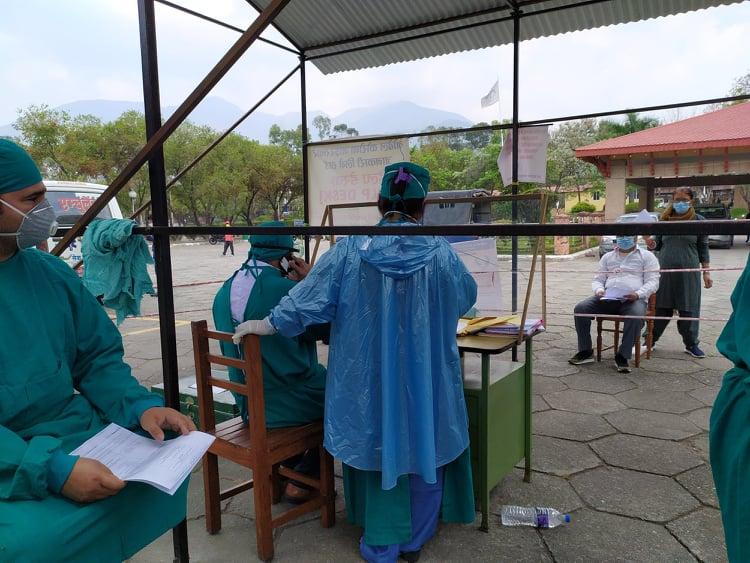Against the backdrop of the global Covid-19 pandemic, “Test, test, test” has been one of the key messages of the World Health Organization (WHO), reiterated over and over again. In almost every country, there is a push to test more, regardless of government capacity. It’s not surprising that many people feel angry and frustrated over the weak health systems of Low- and Middle Income countries (LMICs), at a time when even developed countries are struggling.
Bottlenecks to large-scale testing are mainly affordability, accessibility and capacity, both financial and technical. All these correlate with global inequity. The neglected health sectors of LMICs, still fighting with Neglected Tropical Diseases (NTDs) (as is the case in my country), can never adequately ‘test, test, test’.
Though many countries are increasing the number of tests, the current testing method will never suffice to assess the situation in a systematic and comprehensive way. In many LMICs, we are not even able to test vulnerable populations including those kept in quarantine.
Many experts have speculated that there is a chance of another wave of infection by SARS-CoV-2 after the current infection-control measures such as lockdown and social distancing are lifted. Besides extending lockdown, although probably in a more targeted way, countries need to streamline strategies as per the latest COVID-19 related evidence. In this regard, it is important to note that enteric (gastro-intestinal) involvement and presence of SARS-CoV-2 in stool of infected people has recently been invoked by scientists for sewage-based epidemiology or wastewater-based epidemiology (WBE). A similar method, namely ‘environmental surveillance’, has been used for Polio surveillance by WHO, for the Hepatitis A virus and Norovirus surveillance in Sweden, for detecting illicit drug abuse and harmful chemicals screening in the United States and in many other countries. And let’s not forget the data-rich sewage being used for monitoring antimicrobial resistance (AMR).
WBE involves testing traces of coronavirus genetic material or nucleic acid (RNA) in sewage, using reverse transcription PCR (RT-qPCR), a laboratory technique of molecular biology. Wastewater testing is being piloted as a non-invasive way to measure the status of the coronavirus infection at population level in many countries, including the Netherlands, Australia, France, China, UK, United States and recently India as well.
Prof. Christian Daughton, the pioneer scientist on the wastewater-based epidemiology (WBE) concept, points towards the importance of making governments worldwide aware of the role that sewage epidemiology could play in controlling the spread of Covid-19.
Knowing all this, should LMICs be testing sewage as an indicator for community level data on COVID-19 infection? Are WHO or any other global agencies taking initiatives to support LMICs on this? What are the challenges to test sewage by using RT-qPCR in LMICs? Why are LMICs not doing this (yet)?
Living under the third consecutive month of lockdown here in Nepal, while witnessing the logjam in COVID-19 testing and lack of population based data, I emailed my questions to leading scientists Christian Daughton , Rolf Halden and Kyle Bibby. It is their valuable opinions that motivated me to write this blog.
Prof. Christian
Daughton answered, “I don’t think I can recommend whether LIMCs should
be trying to implement WBE for Covid-19 tracking. Keep in mind that while WBE
has been developed over a period of 15 years for community-wide assessment of
illicit drug usage (as well as other types of synthetic chemicals), it has not
experienced broad use for gauging the incidence of community-wide infectious
diseases (such as Covid-19). But many research groups have active R&D
efforts underway. There has been very little collaboration among these efforts to
date, however.”
He further added that the European Commission’s
call for a Feasibility assessment of an EU-wide Wastewater Monitoring System
for SARS-CoV-2 Surveillance on 8th
May is something to look forward to.
Prof. Rolf Halden shared his strong belief in the approach: “Monitoring low-income countries/communities, via WBE surveillance, is a prudent way of better assessing and managing the pandemic.” Last month only, his team published a research analysis (in Science of The Total Environment) which concluded that with just 1% of the resources currently allocated for clinical testing diverted to WBE, vulnerable populations could be protected and community spread contained in a cost-efficient way. Halden said, “Unfortunately, we are preoccupied with diagnosing and combating the epidemic with the analytical solutions we have introduced.”
Another expert, Kyle Bibby, replied,” I know that many agencies are beginning to evaluate this approach (unsure if WHO belongs to that group). I imagine that the only differences in using this approach in LMICs may be: 1. variation in the sewer shed, including number of people served, type of system, and informal connections and 2. access to necessary equipment, reagents, and supplies. ” Kyle Bibby, who was part of the team that reported the first confirmed detection of SARS-CoV-2 in untreated wastewater in Australia, also mentioned that larger studies are underway.
In conclusion, it’s probably not too far-fetched to anticipate that WBE could become a future surveillance tool for SARS-CoV-2. Although an accurate prediction of the infected population by WBE may not be possible due to several factors contributing to degradation of biomarkers, this method can potentially be useful for estimating prevalence in cities, universities, hospitals etc., certainly also in the context of LMICs. Quantifying sewage loadings of combined viable and non-viable virus particles may facilitate rapid identification of hotspots, and thus better-informed mitigation strategies.
The scientific community and governments from LMICs need to gear up to assess the feasibility and usefulness of this (potential) new paradigm in COVID-19 testing. Sewage-based epidemiology might be able to tell us what case-based surveillance misses in resource-poor settings.

Wastewater based epidemiology for developed countries where sewage is organised to gather collectively in a particular location, is more feasible than in a nation like Nepal where individual houses have their own sewage collection system both in urban areas and rural areas.